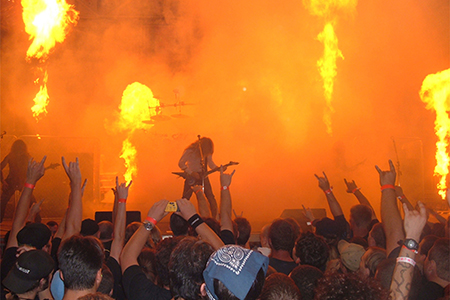Heavy Metal 101: End with a Bang!
-
-
slice.mit.edu
Filed Under
Recommended
Now in its eighth year, the four-part seminar series “Bang Your Head! Heavy Metal 101” is taught by departmental systems administrator Jeffrey Pearlin for MIT’s Independent Activities Period. “Rule number one: Always end with an explosion,” said Pearlin of the music’s tendency to shock critics and awe enthusiasts.

In his first session, Pearlin charted heavy metal’s 50-year history for a crowded room of students and alumni rhythmically bopping their heads (the metal term is head banging) to Pantera’s “Walk,” Judas Priest’s “Metal Gods,” and other musical examples. Many were coming to the lecture series for the third year in a row.
“I think it’s always good to learn more about the music you love,” said Joe Díaz ’10, a metal enthusiast since grade school who majored in music and theater arts at MIT. “For me, that means breaking it down into the components of what makes metal metal.”
Unlike other forms of rock n’ roll that are directly influenced by American Blues music, heavy metal has its roots in earlier rock. Songs often have fast, aggressive drumming, vocals that span from operatic to more intense screaming, and a distorted synthetic tone created by maximizing the wattage going through electric guitar amplifiers. The lyrics run the gamut from themes of liberty and freedom to the satanic and even fantasy.
The British band Black Sabbath is largely credited as first playing heavy metal’s unique synthetic sound out of Birmingham rock houses in the 1960s. Today, Pearlin notes that 70 percent of the world’s countries are home to a recording heavy metal band, and the Encyclopaedia Metallum: The Metal Archives has records of more than 90,000 past or present metal bands.
MIT even has its own connection to heavy metal. Derrick Green, lead singer of Brazilian band Sepultura, is also the brother of Professor Renée Green, director of the MIT Program in Art, Culture, and Technology.
While long hair, tattoos, and black leather are common among fans and musicians, “image is not important,” said Pearlin. “It’s how authentic you are in your metalness.” One true sign of metalness? Making the hand gesture of devil horns to express enthusiasm during concerts.
For those wary of the music’s sound, Pearlin argues that classical music and heavy metal both require years of discipline and practice to understand and appreciate the genre. “If the MIT mind can relate to classical music, there’s no reason why the MIT mind could not relate to the musicality behind heavy metal,” he said.
Many more MIT minds are starting to relate to heavy metal. In addition to Heavy Metal 101, Pearlin has been tapped by MIT professors to conduct guest lectures on heavy metal as a globalized music and offer analysis of metal band Mastodon’s musical interpretation of Moby Dick.
The remaining seminars will be held January 23 and 30 from 5-6 p.m. and are free and open to the public.







